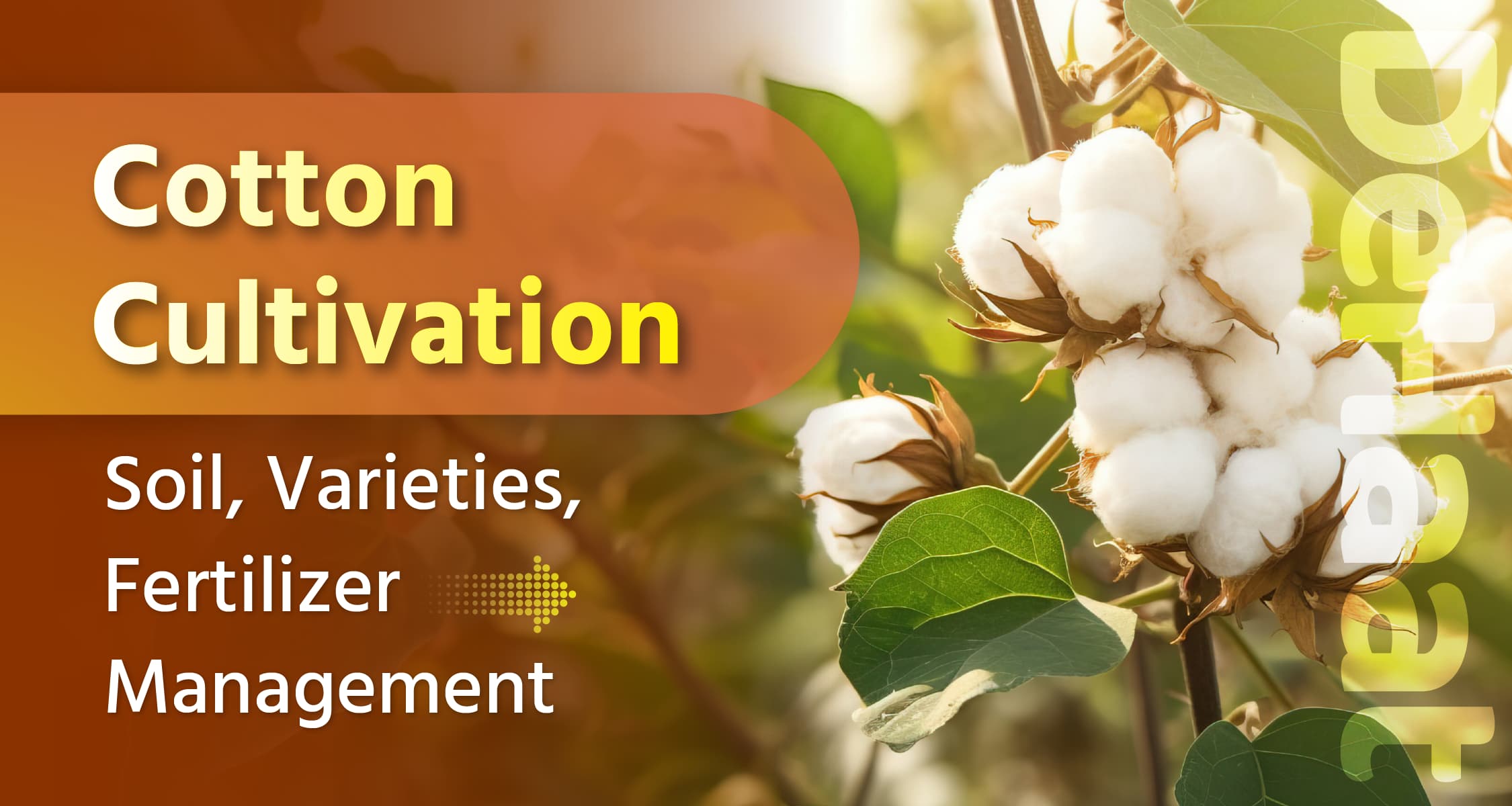Cotton Cultivation: Suitable Soil, Varieties, Fertilizer Management

Cotton is considered to be a major cash crop and its cultivation yields substantial profits to farmers. Considering its monetary benefits, people also call it 'white gold'. Cultivation of cotton can be successfully done in both irrigated and non-irrigated areas. To obtain better yields and high-quality crops, suitable soil, superior varieties, field preparation, irrigation, and fertilizer management are essential. Here, in this post, we will go through vital aspects that need to be considered for a successful and healthy harvest.
How to Cultivate Cotton?
- Selection of Land: Choose soil with good water retention capacity for cultivating cotton. Sandy loam or clay loam is suitable for better yield. The pH level of the soil should be between 6.0 to 7.5.
- Sowing Time: In northern India, cotton is sown from mid-March to mid-April depending on the weather conditions. In central India, sowing is done from mid-May to mid-June. In southern regions, sowing takes place in June-July. Coastal areas sow cotton from May to June.
- Seed Quantity and Seed Treatment: The quantity of seeds depends on the variety. For hybrid varieties, 1.25 kg of seeds are needed per acre. For BT cotton cultivation, 600 gm of seeds per acre is required. It's essential to treat the seeds before sowing to protect the crop from diseases.
- Varieties: Varieties of cotton with long fibers are the best, with a length of about 5 cm. Varieties with fibers ranging from 3.5 to 5 cm in length are categorized as medium staple cotton, while those with fibers of 3.5 cm are included in the short-staple category. Selection of its varieties should be done according to the regions. To achieve good yields, varieties such as Rasi 659, Kaveri ATM, Mahyco Jungee, Ajeet 155 DCS-1102, Seedpro 8694, Rasi Super 773, Crystal 7007, Mahyco Balraj, etc., can be chosen.
- Field Preparation: While preparing the field, first clear the remnants of the previous crop. Then, plow once to a depth of 6 to 8 inches. After that, plow lightly twice to make the soil friable. Make proper arrangements for water drainage in the field to avoid waterlogging.
- Fertilizer Management: Use 4 tons of cow dung manure per acre in the field. Along with this, use 20 kg of urea and 20-30 kg of DAP fertilizer per acre. For better productivity, use 8 kg of 'DeHaat Nutri One Zinc Sulfate Monohydrate' per acre.
- Method of Sowing: Sow in rows with a distance of 48-53 inches between rows and 12-18 inches between plants. The seeds should be sown at a depth of approximately 5 cm.
- Irrigation Management: Paying attention to irrigation is very important in cotton cultivation. If rainfall or irrigation occurs within 2-3 days after sowing, a hard crust forms on the soil surface, preventing germinated seedlings from emerging. The first irrigation in the crop should be done 4-6 weeks after sowing. After that, irrigation is necessary at the time of branching in plants and at the time of flowering and fruiting. Irrigation should also be done after 95-105 days and 115-125 days of sowing.
- Weed control: To get rid of the weed problem in the cotton crop, do weeding as per the requirement. The first weeding can be done 20 to 25 days after sowing. Do the weeding a second time, 50 to 60 days after sowing. You can also keep the crop free from weeds by using chemical medicines. However, pay special attention to the quantity while using chemicals in the fields.
- Disease and Pest Management: The outbreak of diseases and pests in cotton crops can be a major cause of yield reduction and quality degradation. Diseases and pests such as pink bollworm, thrips, whitefly, green leafhopper, bollworm, mealybug, root rot disease, fusarium wilt, etc., are more prevalent in cotton crops. To protect the crops from these diseases, regularly inspect the fields. Use appropriate pesticides when symptoms of any disease or pest are observed. In case of an increase in the incidence of diseases and pests, seek immediate advice from agricultural experts.
- Harvesting: Select cotton bolls after they have ripened. Pick cotton at intervals of every 7-8 days. Choose cotton without dried leaves. After selecting, clean the cotton thoroughly before taking it to the market.
Which variety of cotton do you cultivate and how much yield do you get from it? Please share your answer and experience with us in the comments. For agri-related information, you can also contact experts by calling the toll-free number 1800-1036-110. Don't forget to like and share this post. Follow the 'Krishi Gyan' channel now for more such information.
Frequently Asked Questions (FAQs)
Q: In which months is cotton sown?
A: Cotton is usually sown during the Kharif season, which is in the months of May and June. However, the timing of sowing may vary based on the region and weather conditions. In some areas, sowing can also be done in the month of April.
Q: What fertilizers should be used in cotton farming?
A: To ensure better growth of cotton, it is necessary to use fertilizers in balanced quantities. It is advisable to use Urea, Di-ammonium Phosphate (DAP), Muriate of Potash (MOP), along with Single Super Phosphate (SSP) fertilizer in appropriate quantities.
Q: How to sow cotton?
A: Before sowing cotton, it is necessary to consider several factors, including soil preparation, seed selection, seed quantity, seed depth, use of fertilizers, etc.
जारी रखने के लिए कृपया लॉगिन करें

फसल चिकित्सक से मुफ़्त सलाह पाएँ
